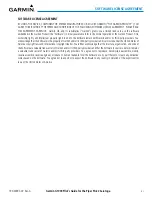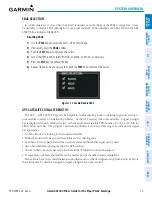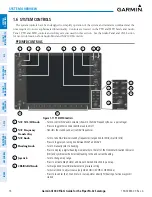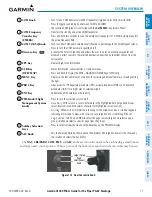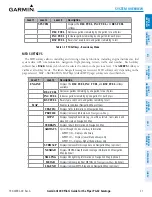
Garmin G1000 Pilot’s Guide for the Piper PA-32 Saratoga
190-02692-00 Rev. A
6
SYSTEM OVERVIEW
SY
STEM
O
VER
VIEW
FLIGHT
INSTRUMENTS
EIS
AUDIO P
ANEL
& CNS
FLIGHT
MANA
GEMENT
HAZARD
AV
OID
ANCE
AFCS
ADDITIONAL FEA
TURES
APPENDICES
INDEX
1.5 SYSTEM OPERATION
NOTE:
In normal operating mode, backlighting can only be adjusted from the PFD. In Reversionary Mode,
it can be adjusted from the remaining display.
The displays are connected to each other for high-speed communication. As shown in Figure 1-1, each IAU is
connected to the on-side display. Normal and reversionary system display operation, as well as the various AHRS
modes and system annunciations, are discussed here.
NORMAL DISPLAY OPERATION
In normal operating mode, the PFD presents graphical flight instrumentation (attitude, heading, airspeed,
altitude, vertical speed), replacing the traditional flight instrument cluster (see the Flight Instruments Section
for more information). The MFD normally displays a full-color moving map with navigation information (see
the Flight Management Section), while the left portion of the MFD is dedicated to the Engine Indication System
(EIS; see the EIS Section). Both displays offer control for COM and NAV frequency selection.
Figure 1-5 Normal Operation
REVERSIONARY DISPLAY OPERATION
NOTE:
The system alerts the pilot when backup paths are utilized by the LRUs. Refer to the Appendices for
further information regarding system-specific alerts.
In the event of a display failure, the system automatically switches to Reversionary (backup) Mode. In
Reversionary Mode, all important flight information is presented on the remaining display in the same format
as in normal operating mode.
If a display fails, the appropriate interface between that display and the associated IAU is cut off. Thus, the
IAU can no longer communicate with the remaining display (refer to Figure 1-1), and the NAV and COM
functions provided to the failed display by the IAU are flagged as invalid on the remaining display. The system
reverts to backup paths for the AHRS, ADC, Engine/Airframe Unit, and Transponder, as required. The change
to backup paths is completely automated for all LRUs and no pilot action is required.
If the system fails to detect a display problem, Reversionary Mode may be manually activated by pressing the
Audio Panel’s red
DISPLAY BACKUP
Button. Pressing this button again deactivates Reversionary Mode.


